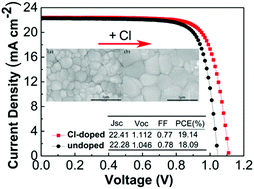Suppressed hysteresis and enhanced performance of triple cation perovskite solar cell with chlorine incorporation†
Abstract
Cs/FA(CH(NH2)2+)/MA(CH3NH3+) triple cation composition engineering is considered as an effective strategy to achieve high performance devices due to the excellent bandgap, uniform film and highly thermal stability. However, hysteresis, as a common phenomenon in perovskite solar cells (PSCs), of the triple-cation perovskite based PSCs has become a complex issue to be solved on the road to the commercialization of PSCs. The introduction of Cs into small perovskite grains resulted in more grain boundaries for ions accumulation. Herein, we demonstrate a unique method to suppress J–V hysteresis and enhance the photoelectric performance via Cl doping into a CsFAMA precursor. We found that the grain size, perovskite crystallinity, and charge carrier lifetime significantly improved with the Cl incorporation. By optimizing the molar ratio of MABr and PbCl2, we achieved the optimal Cl-doped concentration in the perovskite film. 19.14% efficiency for a small area cell and 15.11% efficiency for a 5 × 5 cm2 large area mini-module were achieved based on the mesoporous structured devices. These results suggest that Cl-incorporated triple-cation perovskite (labeled CsFAMAClx) is an attractive absorber for producing efficient large area PSCs.

- This article is part of the themed collection: 2018 Journal of Materials Chemistry C HOT Papers


 Please wait while we load your content...
Please wait while we load your content...